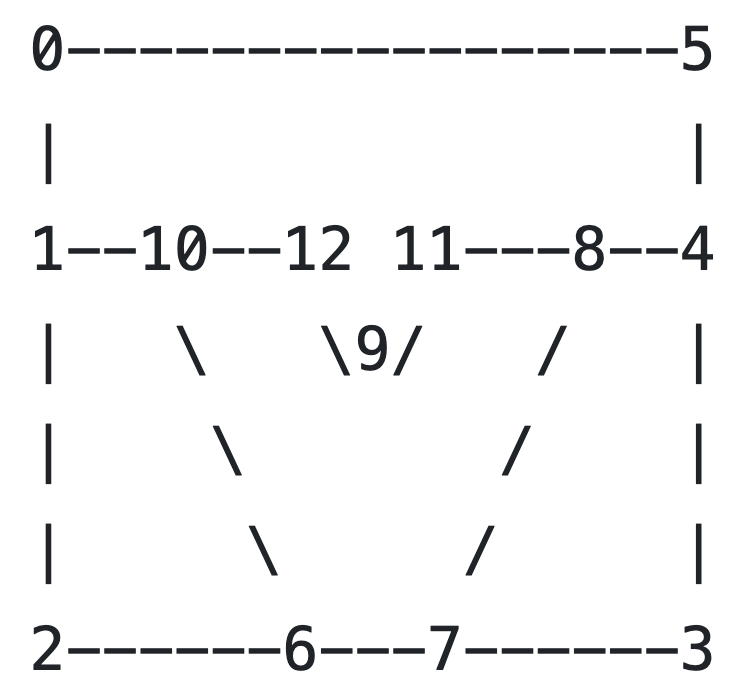Multi-Material Model
Currently, DES is only set-up to run one rheology at a time, so all
layers in a model must have the same rheology time (e.g.
elasto-visco-plastic or elasto-plastic). A multilayer example is
available in the folder DynEarthSol/examples/ ; look at files
rifting-2d.cfg and rifting-2d.poly. The .poly file holds
information about the layer geometry and the configuration file tells
DES where to look for that information.
In .cfg file
- In
[mesh]section, specifypoly_filename: e.g.,
poly_filename = rifting-2d.poly
- In
[mat]section, specifynum_materials: e.g.,
num_materials = 4
- Provide as many values as
num_materialsfor all the material properties (e.g.rho0,lambda,mu, etc): e.g.,
rho0 = [ 2800, 2900, 3210, 3300 ]
- We recommend you draw a schematic such as the one in
rifting-2d.polyto illustrate your layers with labeled nodal points (shown below):
In .poly file
In this file, you will define
- node coordinates
- segments connecting coordinates
- regions
- Node coordinates As in the example .poly file, specify the number of total nodes and number of dimensions. Then specify the node number (starting from 0) and the x- and y-coordinates.
#### node coordinates ####
# npoints ndims 0 0
13 2 0 0
# i xi yi
0 0.0 0.0
1 0.0 -35.0e3
2 0.0 -150.0e3
3 500.0e3 -150.0e3
4 500.0e3 -35.0e3
5 500.0e3 0.0
6 150.0e3 -150.0e3
7 350.0e3 -150.0e3
8 380.0e3 -35.0e3
9 250.0e3 -39.0e3
10 120.0e3 -35.0e3
11 300.0e3 -35.0e3
12 200.0e3 -35.0e3
- Segments As in the example .poly file, specify the number of total segments connecting any 2 nodes. Then specify the segment number (starting from 0) and the nodes it connects (e.g. in the picture of rifting-2d.poly's scheme above, segment 0 connects nodes 0 and 1. Segment 9 connects nodes 10 and 12.) Finally, assign a boundary flag. Flags:
- 0: not a boundary
- 1: left boundary (x0)
- 2: right boundary (x1)
- 16: bottom boundary (z0)
- 32: top boundary (z1)
#### segments ####
# nsegments 1
16 1
# j pj0 pj1 bdry_flag
0 0 1 1 # 1: left (x0)
1 1 2 1
2 2 6 16 # 16: bottom (z0)
3 6 7 16
4 7 3 16
5 3 4 2 # 2: right (x1)
6 4 5 2
7 5 0 32 # 32: top (z1)
8 1 10 0 # 0: not a boundary
9 10 12 0
10 12 9 0
11 9 11 0
12 11 8 0
13 8 4 0
14 10 6 0
15 8 7 0
- Holes In tectonic moeling, there is no reason to deal with an undergroun empty space.
#### holes, must be 0 ####
0
- Regions As in the example .poly file, specify the number of
total regions. Then specify the region number (starting from 0) and a
point within that region (we recommend choosing a fairly central node
here). The
mattypespecifies which value in the .cfg file [mat] paramter should be applied to the region. Finally, specify the max element size (m^2) for the region. If there is no upper limit on element size, use-1.
#### regions ####
# nregions
4
# k xk zk mattype size
0 250e3 -20e3 0 2e7 # max. element size (in m^2)
1 250e3 -80e3 1 4e7
2 1e3 -80e3 1 -1 # no upper limit on elem size
3 450e3 -80e3 1 -1